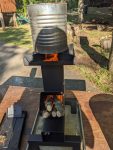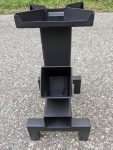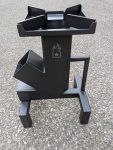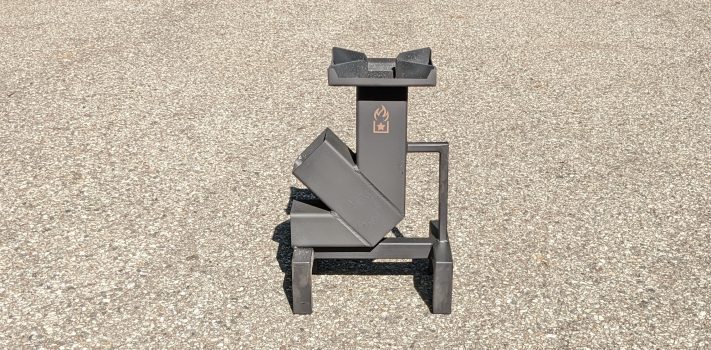The Minuteman “K” Rocket Stove is an outstanding biomass-fueled stove for grid-down situations or for recreational use. The stove is easy to light and easy to feed. It is easy to remove excess ash from the stove while it is in active use. And the stove provides highly effective heat output that is suitable for use with full-sized cookware.
The stove cost $289.95 at the time of this writing at Minutemanstove.com, including 2 one-pound bags of Maya Stick fatwood fire starter tinder.
If you live in an area that is rich in sticks, twigs, and similar biomass, the “K” stove may provide an excellent grid-down cooking solution.
Background
On May 22, 2023, SurvivalBlog published my review of the original Minuteman Rocket Stove. That stove is cleverly designed to fit inside of an M2A1 .50 cal ammo box. The ammo box design makes the stove highly portable and easy to store. It is also an interesting and fun concept.
Adapting a stove to fit inside of an ammo box inevitably requires certain adjustments. Ideal contours for air flow and ash removal have to be compromised in order to achieve the desired fit.
In spite of these compromises, I was impressed by the performance of the original stove. It is a highly effective cooking solution. But I wanted to see what a rocket stove could do when fully freed from the constraints imposed by the ammo box. The Minuteman “K” Rocket Stove represents such an optimal stove design. I contacted Mr. Lane Miller of the Minuteman Provision Company, and asked if he could provide me with a sample of his “K” stove for testing and evaluation. He was kind enough to agree. Not long afterward, a 25-pound UPS Ground shipping box was delivered to my porch.
First Impressions
A packing list and “Operating Suggestions” were located in the top of the shipping box.
The stove is 20 inches tall from the bottom of its feet to the top of the grate. It measures 13.25 inches from front to back and is 10 inches wide at the base.
A handle made of 1-inch-square steel tube on the back of the stove provides a convenient means of carrying the stove when it is cool.
The feed tube and chimney are made of 10-gauge, 4-inch-square steel tube. The air intake pipe is 10-gauge, 4×3-inch-rectangular steel tube. The legs are 1.5-inch-square steel tube. The grate measures 8 x 8 inches.
The welds are excellently executed. The exterior of the stove is attractively finished with high-temperature paint.
Operating Suggestions
The operating suggestions included a number of interesting tips:
The stove should be used on a flat, stable, non-flammable surface. Coals and ashes may fall out of the air intake pipe during operation.
The stove should only be used outside. The external surface of the stove becomes extremely hot during operation. The use of heavy welding gloves is recommended if the stove needs to be moved during use.
The feed tube should face toward the prevailing wind. This will help to force air through the stove, improving combustion efficiency and heat output.
The stove should be started by igniting tinder in the bottom of the feed tube. Then small sticks should be added until a bed of coals is established. Then larger sticks may be added.
“Multiple smaller sticks make a hotter fire than a few big sticks. Feed the fire with the appropriately sized fuel for different types of cooking.”
Excess ash can be cleaned out through the air intake pipe as ash buildup begins to impede air flow.
The stove should be allowed to cool slowly to avoid cracking the welds. Ash should be removed prior to storage to prevent corrosion.
The stove should be stored in a dry environment. The exterior can be maintained with high-temperature barbeque paint.
Testing
It was a beautiful evening in late May. The temperature was 66 degrees Fahrenheit. A fitful breeze was swirling around the points of the compass, mostly coming from the northwest.
 I set up a folding table in the driveway near the pole barn. I placed the Original Rocket Stove and the “K” Stove side by side on the table. I could put the Original stove directly on the table because of the insulation that lines the ammo can. I put an old metal cookie sheet under the “K” stove to protect the table top from ash and embers that might fall from the air intake pipe.
I set up a folding table in the driveway near the pole barn. I placed the Original Rocket Stove and the “K” Stove side by side on the table. I could put the Original stove directly on the table because of the insulation that lines the ammo can. I put an old metal cookie sheet under the “K” stove to protect the table top from ash and embers that might fall from the air intake pipe.
 I took 2 identical #10 cans, measured 8 cups of water into each, and set them aside for later use. I then took the lid from the ammo box and cut some shavings from a Maya stick into one end of the lid. I then cut the Maya stick in half, and prepared a feather stick using each half of the stick.
I took 2 identical #10 cans, measured 8 cups of water into each, and set them aside for later use. I then took the lid from the ammo box and cut some shavings from a Maya stick into one end of the lid. I then cut the Maya stick in half, and prepared a feather stick using each half of the stick.
Next, I sorted 2 similar piles of dry sticks to use as kindling for each stove. Finally I took a piece of waterproof tinder, placed it in the middle of the shavings that I had cut from the Maya stick, placed the 2 pieces of feathered Maya stick on the shavings, and ignited the waterproof tinder using a ferrocerrium rod.
The waterproof tinder ignited the shavings, which ignited the feather sticks in turn. When the feather sticks were burning well, I dropped 1 down the chimney of each of the stoves. I then added the dry kindling sticks. As the smaller sticks caught, I began adding larger sticks. Within a couple of minutes, each of the stoves was burning vigorously.
Next, I placed 1 of the #10 cans of water on each stove. I continued to add fuel to each stove as appropriate. The “K” stove had better fuel capacity, was easier to feed, and produced a more vigorous flame.
After 10 minutes, the water on the “K” stove began to steam significantly, and within 17 minutes the water was in a full rolling boil.
The original stove began to steam significantly after about 20 minutes. At that point, the combustion chamber began to become clogged with ashes. I knew from past experience that it is possible to bring 8 cups of water to a rolling boil on the original stove, but it takes a certain amount of skill and finesse. Instead, I stopped adding fuel and allowed the stove to burn down.
After both stoves had burned down, I put on heavy gloves and dumped the ashes onto the firepit near the pole barn. I then filled a watering can from one of the rain barrels, and drowned the ashes so that they would not start a fire during the night.
How Rocket Stoves Work
 Hot gases are created as fuel burns in the combustion chamber. These hot gases are lighter than the surrounding air, so they rise up the chimney. The departure of the hot gases from the combustion chamber creates lower pressure inside the chamber. Air rushes into the combustion chamber through the air intake tube to fill this area of lower pressure. This flowing air provides more oxygen to the burning fuel than the still air that was originally in the chamber provided.
Hot gases are created as fuel burns in the combustion chamber. These hot gases are lighter than the surrounding air, so they rise up the chimney. The departure of the hot gases from the combustion chamber creates lower pressure inside the chamber. Air rushes into the combustion chamber through the air intake tube to fill this area of lower pressure. This flowing air provides more oxygen to the burning fuel than the still air that was originally in the chamber provided.
 The additional oxygen causes the fuel to burn more vigorously, which in turn produces an even greater volume of hot gases. These hot gases rise up the chimney even faster. Air rushes into the combustion chamber even faster to take the place of the hot gases that are rising up the chimney. This faster flowing air provides even more oxygen to the burning fuel than the more slowly moving air that preceded it. The process continues to accelerate until the process becomes constrained by the capacity of the chimney to vent hot gases and the capacity of the air intake tube to draw in fresh air to replace the hot gases.
The additional oxygen causes the fuel to burn more vigorously, which in turn produces an even greater volume of hot gases. These hot gases rise up the chimney even faster. Air rushes into the combustion chamber even faster to take the place of the hot gases that are rising up the chimney. This faster flowing air provides even more oxygen to the burning fuel than the more slowly moving air that preceded it. The process continues to accelerate until the process becomes constrained by the capacity of the chimney to vent hot gases and the capacity of the air intake tube to draw in fresh air to replace the hot gases.
The grate is fixed to the top of the chimney. Hot gases leaving the chimney and passing through the grate can heat the items placed upon the grate.
In the case of the “K” stove, the feed tube slopes down into the combustion chamber. This slope allows gravity to help feed new fuel into the chamber more effectively. Also, the horizontal air intake tube provides convenient access for the removal of excess ash so that airflow may remain unimpeded.
Conclusions
Due to better airflow and greater ease of removing excess ash, the “K” stove is much more effective and easier to operate than their Original stove. It produces a hotter flame and can handle larger sticks.
Due to being contained in an ammo box, the Original stove is more portable and easier to store. But the greater effectiveness and ease of use of the “K” stove make it a better solution for most cooking situations.
I have tested many biomass stoves over the years. Many of them were much smaller and lighter than the “K” stove since they were optimized to be carried in the field. Heavier stoves are designed for home use or to be transported by vehicles or pack animals. These heavier stoves heat much more effectively than the lighter units designed for field carry. Of the heavier stoves, the “K” stove is by far the most effective that I have ever tested. I highly recommend it.
Disclaimer
Minuteman Provision Company provided me with a sample of their “K” stove for testing and evaluation. They had previously provided me with a sample of their Original stove for an earlier review. I tried not to let this kindness cloud my objectivity, and I believe that I have succeeded. I did not receive any other financial or other inducement to mention any vendor, product, or service in this article.










